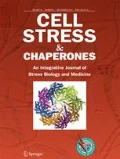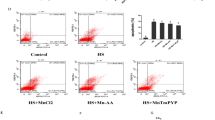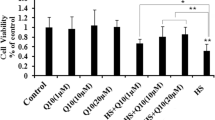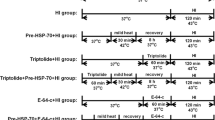Abstract
CRYAB is a small heat shock protein (sHSP) that has previously been shown to protect the heart against various cellular stresses; however, its precise function in myocardial cell injury caused by heat stress remains unclear. This study aimed to investigate the molecular mechanism by which CRYAB protects cardiomyocytes against heat stress. We constructed two H9C2 cell lines that stably express CRYAB protein to differing degrees: CRYAB-5 and CRYAB-7. Both CRYAB-5 and CRYAB-7 showed significantly reduced granular degeneration and vacuolar degeneration following heat stress compared to control cells. In addition, CRYAB overexpression in H9C2 cells relieved cell cycle proportion at the G0/G1 phase following heat stress compared to control cells. These protective effects were associated with the level of CRYAB protein expression. Our immunofluorescence analysis showed CRYAB could translocate from the cytoplasm to the nucleus under heat stress conditions, but that CRYAB co-localized with F-actin (which accumulates under stress conditions). Indeed, overexpression of CRYAB significantly reduced the aggregation of F-actin in H9C2 cells caused by heat stress. Furthermore, overexpressing CRYAB protein significantly reduced the apoptosis of cardiomyocytes induced by heat stress, likely by reducing the expression of cleaved-caspase 3. Collectively, our results show overexpression of CRYAB significantly increases the heat resistance of H9C2 cardiomyocytes, likely by reducing F-actin aggregation (thus stabilizing the cytoskeleton), regulating the cell cycle, and preventing caspase-mediated apoptosis.







Similar content being viewed by others
References
Adhikari AS, Singh BN, Rao KS, Rao CM (2011) AlphaB-crystallin, a small heat shock protein, modulates NF-kappaB activity in a phosphorylation-dependent manner and protects muscle myoblasts from TNF-alpha induced cytotoxicity. Biochim Biophys Acta 1813:1532–1542
Ahmad G, Agarwal A, Esteves SC, Sharma R, Almasry M, Al-Gonaim A, AlHayaza G, Singh N, Al-Kattan L, Sannaa WM, Sabanegh E (2017) Ascorbic acid reduces redox potential in human spermatozoa subjected to heat-induced oxidative stress. Andrologia 49:e12773. https://doi.org/10.1111/and.12773
Aitken-Buck HM, Lamberts RR (2017) To the heart of activation heat. J Physiol 595:4577–4578
Andley UP, Song Z, Wawrousek EF, Brady JP, Bassnett S, Fleming TP (2001) Lens epithelial cells derived from aB-crystallin knockout mice demonstrate hyperproliferation and genomic instability. FASEB J 15:221–229
Arrigo AP (2012) Pathology-dependent effects linked to small heat shock proteins expression: an update. Scientifica 2012:1–19. https://doi.org/10.6064/2012/185641
Bai F, Xi J, Higashikubo R, Andley UP (2004) A comparative analysis of alphaA- and alphaB-crystallin expression during the cell cycle in primary mouse lens epithelial cultures. Exp Eye Res 79:795–805
Bakthisaran R, Tangirala R, Rao CM (2015) Small heat shock proteins: role in cellular functions and pathology. Biochim Biophys Acta 1854:291–319
Basha E, O’Neill H, Vierling E (2012) Small heat shock proteins and alpha-crystallins: dynamic proteins with flexible functions. Trends Biochem Sci 37:106–117
Brady JP, Garland DL, Green DE, Tamm ER, Giblin FJ, Wawrousek EF (2001) aB-crystallin in lens development and muscle integrity: a gene knockout approach. Investig Ophthalmol Vis Sci 42:2924–2934
Crandall CG, Wilson TE (2015) Human cardiovascular responses to passive heat stress. Comprehensive Physiology 5:17–43
Canaud G, Bonventre J (2015) Cell cycle arrest and the evolution of chronic kidney disease from acute kidney injury. Nephrol Dial Transplant 30:575–583
Cui J, Sinoway LI (2014) Cardiovascular responses to heat stress in chronic heart failure. Current Heart Failure Reports 11:139–145
David AM, Elisa KT, Mark R, Roger S, George Y, Kenneth K, Chan EC (2008) Contraction in human myometrium is associated with changes in small heat shock proteins. Endocrinology 149:245–252
Dimauro I, Antonioni A, Mercatelli N, Caporossi D (2017) The role of alphaB-crystallin in skeletal and cardiac muscle tissues. Cell Stress Chaperones. https://doi.org/10.1007/s12192-017-0866-x.
Ito H, Kamei K, Iwamoto I (2001) Phosphorylation induced change of the oligomerization state of alpha B-crystallin. J Biol Chem 276:5346–5352
Ito H, Okamoto K, Nakayama H (1997) Phosphorylation of alphaB-crystallin in response to various types of stress. J Biol Chem 272:29934–29941
Kamradt MC, Chen F, Sam S, Cryns VL (2002) The small heat shock protein alpha B-crystallin negatively regulates apoptosis during myogenic differentiation by inhibiting caspase-3 activation. J Biol Chem 277:38731–38736
Kato K, Ito H, Kamei K (1998) Phosphorylation of alphaB-crystallin in mitotic cells and identification of enzymatic activities responsible for phosphorylation. J Biol Chem 273:28346–28354
King AM, Macrae TH (2015) Insect heat shock proteins during stress and diapause. Annu Rev Entomol 60:59–75
Kumarapeli AR, Su H, Huang W, Tang M, Zheng H, Horak KM, Li M, Wang X (2008) Alpha B-crystallin suppresses pressure overload cardiac hypertrophy. Circ Res 103:1473–1482
Laplante AF, Moulin V, Auger FA, Landry J, Li H, Morrow G, Tanguay RM, Germain L (1998) Expression of heat shock proteins in mouse skin during wound healing. J Histochem Cytochem 46:1291–1301
Martin W, Rainer B, Joachim B, Rudolf D, Gerlinde G, Heinz B, Lutsch G (2001) Defined sequence segments of the small heat shock proteins HSP25 and aB-crystallin inhibit actin polymerization. Eur J Biochem 268:2083–2090
Mercatelli N, Dimauro I, Ciafre SA, Farace MG, Caporossi D (2010) AlphaB-crystallin is involved in oxidative stress protection determined by VEGF in skeletal myoblasts. Free Radic Biol Med 49:374–382
Morrow G, Hightower LE, Tanguay RM (2015) Small heat shock proteins: big folding machines. Cell Stress Chaperones 20:207–212
Muraleva NA, Devyatkin VA, Kolosova NG (2017) Phosphorylation of alphaB-crystallin in the myocardium: analysis of relations with aging and cardiomyopathy. Exp Gerontol 95:26–33
Niu ZY, Liu FZ, Yan QL, Li WC (2009) Effects of different levels of vitamin E on growth performance and immune responses of broilers under heat stress. Poult Sci 88:2101–2107
Paul C, Manero F, Gonin S, Kretz-Remy C, Virot S, Arrigo AP (2002) Hsp27 as a negative regulator of cytochrome c release. Mol Cell Biol 22:816–834
Raman B, Ramakrishna T, Mohan CR (2015) Small heat shock proteins: role in cellular functions and pathology. Biochim Biophys Acta 1854:291–319
Ray PS, Martin JL, Swanson EA, Otani H, Dillmann WH, Das DK (2001) Transgene overexpression of aB crystallin confers simultaneous protection against cardiomyocyte apoptosis and necrosis during myocardial ischemia and reperfusion. FASEB J 15:393–402
Salinthone S, Tyagi M, Gerthoffer WT (2008) Small heat shock proteins in smooth muscle. Pharmacol Ther 119:44–54
Shi C, Yang X, Bu X, Hou N, Chen P (2017) Alpha B-crystallin promotes the invasion and metastasis of colorectal cancer via epithelial-mesenchymal transition. Biochem Biophys Res Commun 489:369–374
Soti C, Csermely P (2000) Molecular chaperones and the aging process. Biogerontology 1:225–233
Sottile ML, Nadin SB (2018) Heat shock proteins and DNA repair mechanisms: an updated overview. Cell Stress Chaperones 23:303–315
Tang S, Chen H, Cheng Y, Nasir MA, Kemper N, Bao E (2016a) Expression profiles of heat shock protein 27 and alphaB-crystallin and their effects on heat-stressed rat myocardial cells in vitro and in vivo. Mol Med Rep 13:1633–1638
Tang S, Yin B, Song E, Chen H, Cheng Y, Zhang X, Bao E, Hartung J (2016b) Aspirin upregulates alphaB-Crystallin to protect the myocardium against heat stress in broiler chickens. Sci Rep 6. https://doi.org/10.1038/srep37273
Xu J, Tang S, Yin B, Sun J, Song E, Bao E (2017) Co-enzyme Q10 and acetyl salicylic acid enhance Hsp70 expression in primary chicken myocardial cells to protect the cells during heat stress. Mol Cell Biochem 435:73–86
Xu J, Tang S, Yin B, Sun J, Bao E (2018) Co-enzyme Q10 upregulates Hsp70 and protects chicken primary myocardial cells under in vitro heat stress via PKC/MAPK. Mol Cell Biochem. https://doi.org/10.1007/s11010-018-3356-2
Yamamoto S, Yamashita A, Arakaki N, Nemoto H, Yamazaki T (2014) Prevention of aberrant protein aggregation by anchoring the molecular chaperone alphaB-crystallin to the endoplasmic reticulum. Biochem Biophys Res Commun 455:241–245
Yin B, Tang S, Sun J, Zhang X, Xu J, Di L, Li Z, Hu Y, Bao E (2018) Vitamin C and sodium bicarbonate enhance the antioxidant ability of H9C2 cells and induce HSPs to relieve heat stress. Cell Stress Chaperones 23:735–748. https://doi.org/10.1007/s12192-018-0885-2
Zhang K, Ezemaduka AN, Wang Z, Hu H, Shi X, Liu C, Lu X, Fu X, Chang Z, Yin CC (2015) A novel mechanism for small heat shock proteins to function as molecular chaperones. Sci Rep 5. https://doi.org/10.1038/srep08811
Funding
The current study was supported by the grants from the National Natural Science Foundation of China (grant no. 31672520), the Fundamental Research Funds for the Central Universities (grant no. KJQN201709), the National Natural Science Foundation of China (grant no. 31602027), the National Natural Science Foundation of China (grant no. 31372403), Jiangsu Natural Science Foundation of China (grant no. BK20160732), China Postdoctoral Science Foundation (2016M591860), and Shandong Natural Science Foundation of China (grant no. ZR2016CM40).
Author information
Authors and Affiliations
Corresponding author
Rights and permissions
About this article
Cite this article
Yin, B., Tang, S., Xu, J. et al. CRYAB protects cardiomyocytes against heat stress by preventing caspase-mediated apoptosis and reducing F-actin aggregation. Cell Stress and Chaperones 24, 59–68 (2019). https://doi.org/10.1007/s12192-018-0941-y
Received:
Revised:
Accepted:
Published:
Issue Date:
DOI: https://doi.org/10.1007/s12192-018-0941-y




